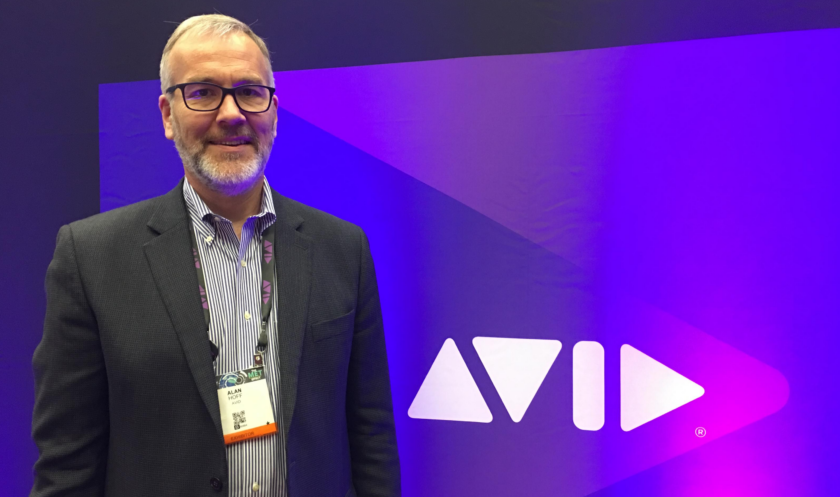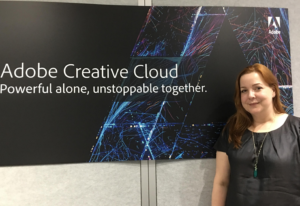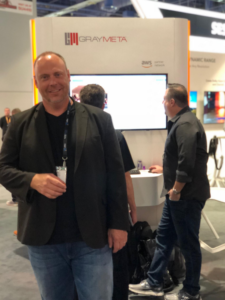M+E Daily

Live at NAB Show: MESA Members Talk Digital Asset Management, AI, and More
Story Highlights
LAS VEGAS — Members of the Media & Entertainment Services Alliance (MESA) brought a variety of new offerings to the annual NAB Show, covering artificial intelligence (AI), and machine learning, digital asset management, virtual reality, and more.
Here’s a look at what 5th Kind, Adobe, Avid, Globecast and GrayMeta had to share.
5th Kind
“The main story that we’re driving here is a new category” within the digital asset management space, 5th Kind CEO and founder Steve Cronan told MESA at the show. “We’re trying to be synonymous with the idea of a studio asset management” (SAM) system, he said.
What sets 5th Kind’s system apart from competing systems on the market is its “holistic approach to the full life cycle of a file” at every point of the creative process, he said.
 The company touted its new user interface (UI) at the show, he noted, saying customers are “really connecting with” it and the extreme flexibility that it offers. The new UI was finalized in December and is part of the latest version of 5th Kind’s CORE comprehensive SAM platform, he said, calling it a “complete rebuild from the ground up” that took three years to complete, including one year of design and two years building it, with the last six months of those two years devoted to beta testing, he said.
The company touted its new user interface (UI) at the show, he noted, saying customers are “really connecting with” it and the extreme flexibility that it offers. The new UI was finalized in December and is part of the latest version of 5th Kind’s CORE comprehensive SAM platform, he said, calling it a “complete rebuild from the ground up” that took three years to complete, including one year of design and two years building it, with the last six months of those two years devoted to beta testing, he said.
5th Kind added new dailies workflow features to the CORE platform, it said just ahead of the show, noting some of the key dailies features include: AI capabilities, such as speech-to-text and facial recognition; Aspera integration for all uploads and downloads; high-speed transcoding to create multiple resolution proxies; Akamai’s Content Delivery Network (CDN) for global high quality streaming; visual and forensic watermarking; one-click access across desktop, mobile and Apple TV; extremely granular access controls that users can manage; infinitely configurable metadata; and multi-factor, signal sign-on (SSO).
Adobe
Adobe’s focus at this year’s NAB Show was touting all the major features of the “broad update” the company has made to its audio and video tools, Laura Williams Argilla, director of product management for Creative Cloud for Video, told MESA at the show.
 Echoing comments she made to reporters in a virtual online news briefing just ahead of the show, Argilla said: “One of the things that we’re hearing a lot about is how people who are making video are being asked to make more video.
Echoing comments she made to reporters in a virtual online news briefing just ahead of the show, Argilla said: “One of the things that we’re hearing a lot about is how people who are making video are being asked to make more video.
And video consumption is at an all-time high. If you look at the percentage of Internet traffic that’s video, it just keeps growing, and it’s growing faster than was projected even just a couple of years ago. But the problem is that people aren’t being given any more time to make all of this content, so they’re expected to do more in less time. And, because there’s this boom in content – so much of it out there, so many people vying for viewership – your content really has to look amazing in less time for multiple platforms, and that’s a really difficult set of themes to juggle.”
The updates introduced by Adobe stand to help customers meet those challenges, according to the company. “Our theme this cycle was Powerful Alone, Unstoppable Together,” Argilla said, adding: “Using the tools together actually gives you much better results, in less time – and that’s not just the tools themselves, but the ecosystem around the Creative Cloud, with our partnerships. We have over 140 partners showing Premiere… throughout the show halls” this year.
The significant update to Adobe Creative Cloud that Adobe announced added several new features, including enhanced virtual reality (VR) tools and advanced AI powered by the company’s Sensei AI and machine learning platform.
Avid
Avid spotlighted its latest creative tools, apps and services at this year’s NAB Show.
One focus for the company continues to be finding new ways to improve the user experience across all Avid offerings, according to Alan Hoff, VP of market solutions.
When he joined the company, “one of the pet projects I had was to look at how we can make the customer journey – the user experience – more consistent across” its Creative Tools products, including licensing and pricing and support policies, he said.
The major expansion Avid introduced for its Creative Tools Family provides access to Avid’s Pro Tools, Media Composer and Sibelius software for creative individuals “at any stage of their career and teams of any size,” the company said at its fifth Avid Connect event in Las Vegas, just before it demonstrated the new features at NAB.
In the process, “we straightened out our branding, for consistent branding across our Creative Tools,” introducing new, improved packaging that’s “much more optimized for a retail setting,” Hoff said.
To help users deliver their best work, Avid also introduced the Avid Connect App, which it said will be available to all of Avid’s 1.4 million account holders this summer, “delivering a centralized ‘one-stop’ experience for artists to find, connect and collaborate with each other on any laptop, iOS or Android device.”
 The company also announced several new features that extend the benefits of its MediaCentral platform with “advancements for creative and aspiring professionals, production teams and media enterprises across news, sports, live production and post production,” it said.
The company also announced several new features that extend the benefits of its MediaCentral platform with “advancements for creative and aspiring professionals, production teams and media enterprises across news, sports, live production and post production,” it said.
Highlights included Avid On Demand, a new Software-as-a-Service (SaaS) cloud services and solutions platform that provides media production capabilities on demand.
Avid On Demand services include Avid AI, a new suite of Avid and third-party capabilities that automate content indexing, such as closed captioning verification, language detection, facial recognition, scene detection and speech-to-text conversion.
Avid AI services introduced at Avid Connect included Avid Phonetic Search, Avid Illuminate On Demand, Microsoft Cognitive Services and Avid Transformation. Avid On Demand cloud solutions include Avid Shared Library On Demand and Avid Editorial On Demand.
When it comes to customer demand, Shared Library On Demand has been “number one with a bullet for our largest customers,” Hoff told us, explaining that it’s a “centralized content library that can serve both as an active content library, as well as an archive.”
Globecast
The focus for Globecast at this year’s NAB Show was to announce to the market that “we are going to be very active in developing a virtualized cloud origination and playout service globally,” Eddie Ferraro, managing director for The Americas, told MESA at the show. Globecast is virtualizing its media centers in L.A., Singapore and London, he said.
The company announced just before the show that it was launching the first of its Cloud Playout services at this year’s NAB. Globecast has been developing and honing its cloud playout platform over the past year and is initially announcing a range of long-term and on-demand services. In announcing the launch, COO Sylvain Merle said, “Cloud playout brings a whole new level of flexibility, with very fast times to launch.”
 Globecast’s solution uses object storage, which provides the schedules and content from cloud-native storage platforms, a virtualized playout engine (as well as a virtualized graphics engine), stream handling for high availability broadcast delivery, compliance recording and origin server/CDN for global web/mobile consumption.
Globecast’s solution uses object storage, which provides the schedules and content from cloud-native storage platforms, a virtualized playout engine (as well as a virtualized graphics engine), stream handling for high availability broadcast delivery, compliance recording and origin server/CDN for global web/mobile consumption.
With it, Globecast can launch services in a matter of minutes and all services use a combination of a private and public cloud, it said.
Globecast also touted the technology partnership it announced with Santa Barbara, California-based CBTV for the launch of a new IP-over-satellite transport platform, Ferraro said. Globecast is targeting it for “special event coverage,” he told MESA.
The platform enables media, event producers and content providers to deliver streaming, file transfers, Wi-Fi, 4K, 8K, and 360-degree live content using native IP-based satellite transmission from remote locations, Globecast said. The partnership between CBTV and Globecast “provides high-availability bandwidth and highly efficient satellite capacity in areas where connectivity is limited, damaged, non-existent, or cost prohibitive,” Globecast said. Customers can use the service for a variety of IP-based workflows including: high-bandwidth moving picture content; file transfers; communications redundancy; and IT services between remote sites and home locations — “often reaching beyond existing infrastructure and facilities,” it said.
GrayMeta
GrayMeta has “really been focusing on streamlining compliance workflows and creating efficiencies across organizations” this year, CTO John Motz told MESA.
“With the introduction of our new Adobe Premiere panel, teams can leverage the power of the GrayMeta Platform like never before” and “the response has been overwhelming,” he said.
Asked to name one of the major trends that the company is seeing across the industry, he replied, “When tagging content, reviewing to ensure compliance and converting speech to text. Organizations who leverage AI can free up human capital while increasing productivity by as much 25x.”
 At this year’s NAB Show, GrayMeta announced new partnerships with BeBop Technology and Prime Focus Technologies.
At this year’s NAB Show, GrayMeta announced new partnerships with BeBop Technology and Prime Focus Technologies.
As part of the strategic partnership with BeBop, GrayMeta will be hosted on the BeBop platform and develop a suite of new solutions for content owners.
The first of these tools, to be called Neon, will combine the GrayMeta Platform’s AI, machine learning and automatic metadata creation capabilities with BeBop’s highly secure cloud platform to create a complete workflow solution for compliance and quality control (QC) operations, GrayMeta said.
Content editors will be able to utilize Neon to quickly locate where changes need to be made within their content and enable sign clearance and copyright protection for motion pictures, broadcast, TV, and digital content.
Prime Focus, meanwhile, teamed with GrayMeta to empower media and entertainment enterprises with powerful AI/machine learning capabilities for faster, automation-driven content operations and improved decision making.









